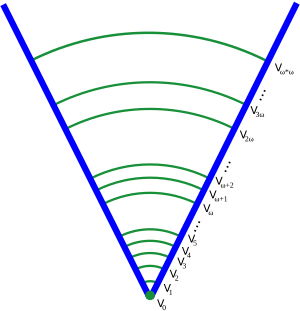란타넘 하파나테
Lanthanum hafnate| 식별자 | |
|---|---|
3D 모델(JSmol) | |
| |
| |
| 특성. | |
| 라호프 2 2 7 | |
| 어금질량 | 746.79 g/190 |
| 외관 | 무색의 고체 |
| 밀도 | 7.86 g/cm3[1] |
| 밴드 갭 | 4.233 eV[1] |
| 구조 | |
| 큐빅 | |
| Fm3m(< 1000°C) Fd3m (> 1000 °C) | |
| 관련 화합물 | |
기타 양이온 | 란타넘 지르코나이트 |
달리 명시된 경우를 제외하고, 표준 상태(25°C [77°F], 100 kPa)의 재료에 대한 데이터가 제공된다. | |
| Infobox 참조 자료 | |
란타넘 해프나이트(LaHfO
2
2
7) 또는 란타넘 해프늄 산화물(Lantanum hafnium oxide)은 란타넘과 하프늄의 혼합물이다.
특성.
란타넘 하프나이트는 라 원자와 Hf 원자를 입방체 격자로 배열한 무색의 세라믹 소재다[2].배치는 1,000 °C(1,270 K, 1,830 °F) 미만의 불소성 구조로, 그 위로 화로클로르 단계로 전환되며, 800 °C(1,070 K, 1,470 °F) 미만의 비정형 위상도 존재한다.[3][4]
그 화합물은 18 GPA에서 그 성분인 산화물로 분해된다.[5]
발광
기초 물질의 산소결핍은 가시광 스펙트럼 전체에 걸쳐 발광을 제공하며, 피크는 거의 460nm에 이른다.[6]발광 특성은 다양한 희토류 및 그룹 4 금속과 도핑하여 미세 조정할 수 있다.[7][8] 예를 들어,LaHfO227:Eu3+ 나노입자는 자외선이나 X선 방사선에 노출되었을 때 612nm에 가까운 적색 광채광 또는 방사선 발광을 나타낸다.[9]
합성
벌크 세라믹은 분말 형태로 원소를 연소시킨 후 180MPa 및 1,850°C(2,120K, 3,360°F)에서 6시간 동안 분말을 눌러 소결할 수 있다.[2]
- 4 La + 4 Hf + 7 O
2 → 2 La
2Hf
2O
7.
또한 용액에서 하프늄과 란타넘 수산화물을 침전시킨 후 600–1,400 °C(873–1,673 K; 1,112–2,552 °F)에서 3시간 동안 공기 중에 석회화하면 된다.[3]
- 2 La(OH)3 + 2 Hf(OH)4 → La2Hf2O7 + 7 H2O.
참조
- ^ a b None Available (2020). "Materials Data on La2Hf2O7 by Materials Project". Materials Project. doi:10.17188/1188964. Retrieved 30 April 2021.
{{cite journal}}:Cite 저널은 필요로 한다.journal=(도움말) - ^ a b Ji, Yaming; Jiang, Danyu; Fen, Tao; Shi, Jianlin (March 2005). "Fabrication of transparent La2Hf2O7 ceramics from combustion synthesized powders". Materials Research Bulletin. 40 (3): 553–559. doi:10.1016/j.materresbull.2004.10.010.
- ^ a b Popov, V V; Menushenkov, A P; Yastrebtsev, A A; Zubavichus, Ya V (September 2016). "La 2 Hf 2 O 7 crystal and local structure changes on the fluorite - pyrochlore phase transition". Journal of Physics: Conference Series. 747 (1): 012043. Bibcode:2016JPhCS.747a2043P. doi:10.1088/1742-6596/747/1/012043.
- ^ Blanchard, Peter E. R.; Liu, Sam; Kennedy, Brendan J.; Ling, Chris D.; Avdeev, Max; Aitken, Jade B.; Cowie, Bruce C. C.; Tadich, Anton (7 February 2013). "Investigating the Local Structure of Lanthanoid Hafnates Ln 2 Hf 2 O 7 via Diffraction and Spectroscopy". The Journal of Physical Chemistry C. 117 (5): 2266–2273. doi:10.1021/jp311329q.
- ^ Garg, Nandini; Pandey, K. K.; Murli, Chitra; Shanavas, K. V.; Mandal, Balaji P.; Tyagi, A. K.; Sharma, Surinder M. (13 June 2008). "Decomposition of lanthanum hafnate at high pressures". Physical Review B. 77 (21): 214105. Bibcode:2008PhRvB..77u4105G. doi:10.1103/PhysRevB.77.214105.
- ^ Eagleman, Yetta; Weber, Marvin; Derenzo, Stephen (May 2013). "Luminescence study of oxygen vacancies in lanthanum hafnium oxide, La2Hf2O7". Journal of Luminescence. 137: 93–97. Bibcode:2013JLum..137...93E. doi:10.1016/j.jlumin.2012.10.034.
- ^ Gupta, Santosh K.; Zuniga, Jose P.; Abdou, Maya; Thomas, Melonie P.; De Alwis Goonatilleke, Manisha; Guiton, Beth S.; Mao, Yuanbing (January 2020). "Lanthanide-doped lanthanum hafnate nanoparticles as multicolor phosphors for warm white lighting and scintillators". Chemical Engineering Journal. 379: 122314. doi:10.1016/j.cej.2019.122314.
- ^ Trojan-Piegza, Joanna; Zych, Eugeniusz (March 2021). "White persistent luminescence of La2Hf2O7:Ti,Pr". Optical Materials. 113: 110896. Bibcode:2021OptMa.11310896T. doi:10.1016/j.optmat.2021.110896. S2CID 233842128.
- ^ Wahid, Kareem; Pokhrel, Madhab; Mao, Yuanbing (January 2017). "Structural, photoluminescence and radioluminescence properties of Eu3+ doped La2Hf2O7 nanoparticles". Journal of Solid State Chemistry. 245: 89–97. Bibcode:2017JSSCh.245...89W. doi:10.1016/j.jssc.2016.10.004.


